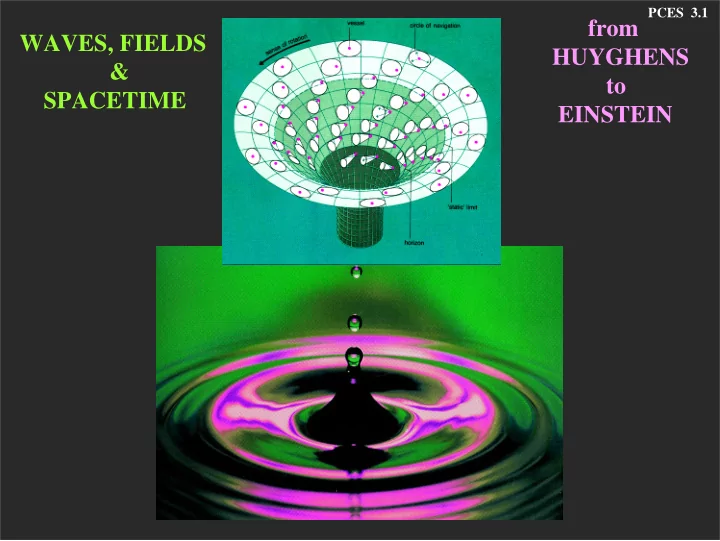

PCES 3.1 from WAVES, FIELDS HUYGHENS & to SPACETIME EINSTEIN
PCES 3.2 THE ADVENT of the FIELD THEORY DECRIPTION of NATURE All of the developments to come in the theory of fields, and even quantum mechanics, were ultimately seeded by the debate between Newton & Huyghens on the nature of light, & by the more philosophical questions concerning ‘action at a distance’ & the nature of space & time, which were left in the wake of Newtonian mechanics. But neither Newton nor Huyghens could possibly have imagined the form of the final synthesis which solved these problems. It involved the following key elements: (i) Key experiments by T. Young, which established the wave theory of light (ii) Key experiments by many workers, most notably Faraday, which established the main features of electrical and magnetic phenomena, their connection, and the existence of electric and magnetic fields. (iii) The grand synthesis by Maxwell – a complete theory of electromagnetic phenomena, in terms of electrical charges and electromagnetic fields moving in space and time. (iv) Most astonishing of all – the realisation of ‘special relativity’ by Einstein, in which space & time were unified as ‘spacetime’; and then the ‘General theory of Relativity’, which made spacetime itself a field, interacting with matter, and with its own dynamics. This last development was done in the complete absence of experiment Even then it wasn’t over – there was still quantum mechanics to come. But this is a later story…..
PCES 3.3 INTERLUDE: INTERFERENCE OF LIGHT WAVE THEORY of LIGHT: Diffraction & Interference Something that can be naturally explained in a wave theory is diffraction & interference- this is a clear prediction for light propagation. One sees in the pictures how water waves passing through a pair of slits are “re-emitted” in the way shown by Huyghens, as though they were being emitted from 2 point sources. The key feature is the constructive interference between the 2 resulting wavefronts in certain directions, & the destructive interference in other directions. LEFT: emission of water waves from 2 point sources- the lower waves have shorter wavelength. RIGHT: Diffraction of wavefront through a single slit (top), and through a pair of slits (bottom).
PCES 3.4 WAVE THEORY of LIGHT: 2-slit interference The 2-slit experiment is basically the same as diffraction from 2 sources. The key feature of the 2-slit experiment with waves is shown here. If only one of the 2 slits is open, the intensity of the waves, on a screen behind the slits, will vary smoothly across the screen (with water waves the intensity can be measured by looking at the amplitude of the wave oscillations at different points along the screen). If however both slits are open, the resulting intensity is NOT the sum of that from each slit. We say that the waves ‘interfere’; it is actually the wave amplitudes that one must sum. To see that this contradicts Newton’s idea that light propagates as a particle, consider what would happen if particles were being emitted from the 2 slits. If the pattern of arrivals of these is as shown for each single slit, then the pattern of arrivals when both are open must be the sum of the 2 patterns for the single slits- there would be no interference.
PCES 3.5 2 slits: continued…. At near right we see wave crests coming from 2 slits (diffraction sources), & how they add in certain directions. At far right the waves propagate to the screen. In the directions between constructive interference, troughs from one slit meet crests from the other, & cancel. A change in wavelength changes the distance between maxima of intensity on the screen- eg., halving the wavelength will halve the distance between maxima. This is clearly seen with light of different colours- interference experiments show that these are simply waves of different wavelength. If we accept that these travel at the same velocity (which they must, otherwise the colour of an object would change with the length of the light path), then the difference in wavelength must also correspond to a difference in the FREQUENCY, ie., the number of wavecrests passing a point every second.
PCES 3.6 PROOF of the WAVE THEORY: T. Young’s Experiment In 1801 Thomas Young carried out a remarkable set of experiments on diffraction, including his famous 2-slit experiment – he had already w orked out the theory of this. What Young realised is show n below – that particle passing through a pair of slits w ould behave completely differently from w aves. This set of experiments w as a triumph for the ‘experimental philosophy’ (as w ell as for Young’s theoretical acumen & the theory of Huyghens). It dethroned New ton’s ideas in the UK. Thomas Young was a remarkable polymath, who at 14 yrs had mastered 15 languages. He made fundamental contributions to physics, medicine & public health, ancient history (he was the first to decipher parts of the Rosetta stone), languages, and music. In physics he is best known for his 2-slit experiment, which at a single stroke established the wave theory of light. He also made fundamental contributions to the theory of elastic solids, & to our understanding of vision & colour perception. What he would have seen in the 2-slit expt is shown below The intensity of the light on the background screen would show multiple bands if it were a wave, but would be concentrated in only 2 bands of it were traveling as particles (see preceding slides).
Recommend
More recommend